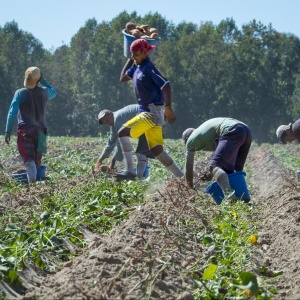
The average number of days that US farm workers spend working in dangerously hot conditions could double by mid-century and triple by the end of the century, according to this paper. Workplace adaptations such as longer rest breaks, working more slowly, switching to single-layer clothing and having cooled rest areas could tackle this problem, but would negatively affect farm productivity, worker earnings and labour costs.
According to the paper, farm workers in the US are already 20 times more likely to die from illnesses related to heat stress than people in the general workforce, and the average US crop worker is exposed to 21 unsafe working days in each summer growing season. Using projections of heat and humidity, the paper finds that for climate change of 2ºC, crop workers will experience an average of 39 days that are above safe heat levels. For 4ºC of climate change, that rises to 62 unsafe days.
The paper recommends that policies to manage workplace heat stress should be rolled out across the whole of the United States (currently only California and Washington have outdoor occupational heat standards), for example requiring heat-appropriate breaks, suitable clothing, worker training, early warning systems and medical monitoring.
Abstract
The over one million agricultural workers in the United States (U.S.) are amongst the populations most vulnerable to the health impacts of extreme heat. Climate change will further increase this vulnerability. Here we estimate the magnitude and spatial patterns of the growing heat exposure and health risk faced by U.S. crop workers and assess the effect of workplace adaptations on mitigating that risk. We find that the average number of days spent working in unsafe conditions will double by mid-century, and, without mitigation, triple by the end of it. Increases in rest time and the availability of climate-controlled recovery areas can eliminate this risk but could affect farm productivity, farm worker earnings, and/or labour costs much more than alternative measures. Safeguarding the health and well-being of U.S. crop workers will therefore require systemic change beyond the worker and workplace level.
Reference
Tigchelaar, M., Battisti, D. and Spector, J., 2020. Work adaptations insufficient to address growing heat risk for US agricultural workers. Environmental Research Letters, Accepted manuscript online 6 April 2020.
Read the full paper here. See also the Foodsource resource How do the climate and environment directly affect the conditions required for food production?







Post a new comment »